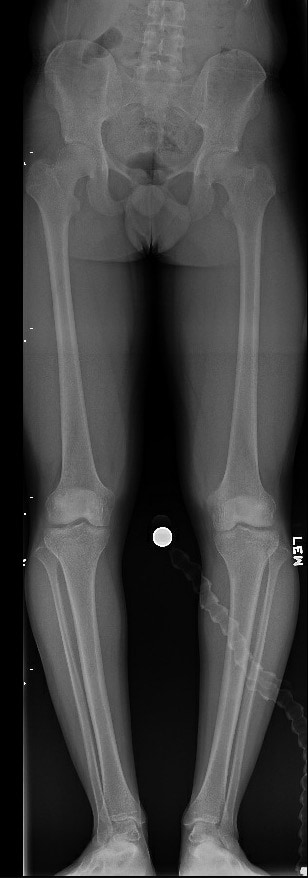BOW LEG CORRECTION
The SAFE Limb Lengthening Solution
At HeightRx, we’re more than just experts in height enhancement — we offer world-class care for patients with complex orthopedic conditions, including malalignment of the knees. Bow legs are a well-known condition associated with improper lower extremity alignment. Bowed legs may cause knee pain and mobility limitations, especially as you grow older, and can be a source of self-consciousness at any age. Corrective surgery can restore your knees to stable, balanced alignment.
Take a step toward a confident and pain-free future. Dr. Michael Assayag, board-certified orthopedic surgeon in Baltimore, Maryland, specializes in treating lower extremity alignment issues using the latest orthopedic techniques. To learn more about bow leg correction and find out if the procedure is right for you, contact HeightRx at the International Center for Limb Lengthening (ICLL) today to request a consultation with Dr. Assayag.

What Are Bow Legs?
Proper alignment of the leg is important for balance and normal function of the knee joint. In an ideal state of alignment, the centers of the hip, knee and ankle joints can be connected with a vertical line. This ensures the body’s weight is transferred evenly through the middle of the knee.
The bow leg deformity (genu varum) is marked by an outward curving of the legs. The lower legs may have a gap between the calf muscles that is larger than what is considered normal or desirable. In advanced cases, the legs can be so severely bowed that the knees are far apart while standing. The cosmetic appearance of bow legs can affect your self-esteem, and over time, the misalignment can intensify the wear-and-tear on your knee joint.
Distinction At a Glance:
- Bow Leg: Feet touching but not knees
- Knock Knee: Knees touching not feet
What Causes Bow Legs?
You may have noticed that it’s common to see bowed legs in toddlers and young children. Believe it or not, this is usually part of normal development. Because the legs are in a folded position in the uterus, children are often born bowlegged, and the legs straighten as the child grows. The alignment typically begins to improve without medical intervention around two years of age.
Outside of normal growth, which is the most common cause of bowleggedness, underlying conditions such as rickets and Blount’s disease can cause malalignment. Cases can also arise in children or adults from injury, infection or improperly healed fractures. Adults who do not receive treatment or receive inadequate treatment for bow legs as children can present with significant deformity, as well as knee pain and degeneration. Premature osteoarthritis that may eventually require knee replacement is a serious risk of leaving bow legs untreated.
What Are the Symptoms of Bow Legs?
Bowed legs may not cause any pain or limitations, particularly early in life. However, over time, persistent bowing can lead to discomfort in the knees due to the abnormal stress placed on the joints. The pain can worsen if the condition is left untreated or the knee is injured because of a stress overload. Other possible symptoms include inflammation, swelling and stiffness.
One of the main concerns for bowlegged patients is the risk of developing knee arthritis. In addition to the uncomfortable symptoms mentioned above, arthritis can lead to limitations with exercise and recreational sports. Eventually, as the condition progresses, it can interfere with normal daily activities.
Bow legs do not need to cause physical symptoms to qualify for surgery. The cosmetic appearance of bowed legs can affect your self-esteem, especially if you were teased or bullied as a child. You may feel that your clothing choices are limited because you’re embarrassed to wear shorts or skirts. You may struggle to maintain an active social life if you don’t feel confident in your appearance. All of these are valid reasons to consider corrective surgery.
How Are Bow Legs Diagnosed?
Visual examination is usually sufficient for bow leg diagnosis. Dr. Assayag will observe the way you stand and walk, as well as the physical structure of the affected joint, to determine the extent of the malalignment. He will also inquire about your medical history and any symptoms you’re experiencing. For additional information, Dr. Assayag may order x-rays so he can assess the severity of the condition and determine which surgical technique is appropriate.
What Is Bow Leg Correction?
Surgical bow leg correction is the only effective option for adults. Mild bowleggedness in children can sometimes be improved with special shoes, braces or therapy, but there are no nonsurgical options that can realign bowed legs for adult patients. At best, conservative measures such as activity modification and braces may decrease the symptoms associated with bow legs.
The procedure most commonly used to correct bowed legs is called osteotomy. During the procedure, Dr. Assayag cuts the relevant bones above or below the knee and realigns them. Adjusting the angle of the bones restores even weight-bearing through the knee and lowers the risk of joint degeneration.
Is Bow Leg Correction Right for Me?
Osteotomy can deliver significant improvements in confidence, symptoms and knee function. Typically, the best candidates for bow leg surgery meet the following criteria:
- Are under 60 years of age
- Do not smoke
- Are not overweight
- Can limit weight bearing for six to eight weeks post-surgery
- Are motivated to complete a physical therapy regimen
Before surgery is performed, Dr. Assayag will explain your treatment options and help you choose the best one for you based on the extent of the bowing, your activity level and your age.
The Bow Leg Correction Procedure
Tibial osteotomy is the most common corrective surgery for bowed legs. During this procedure, Dr. Assayag makes a small incision in the front and/or the side of the knee to expose the tibia (the shin bone). He then removes a wedge-shaped section of the tibia just below the knee. This allows him to adjust the leg by closing the gap in the bone like a hinge. To complete the procedure, Dr. Assayag anchors the edges of the cut bone into their new position with plates and screws.
In some cases, Dr. Assayag will adjust the femur (the thigh bone) instead of or in addition to the tibia. He will determine which bone to target based on x-ray findings that identify the location of the deformity.
What to Expect After Your Bow Leg Correction Surgery
Optimal recovery is a collaboration between you and your medical team. Dr. Assayag will prescribe medications to help you manage pain, inflammation and nausea after your surgery. He may also prescribe a blood thinner and an antibiotic, as well as vitamin D3 and calcium supplements to assist with bone healing.
You will need physical therapy after bow leg correction surgery. This part of your recovery journey helps to promote muscle strengthening, maintain or increase range of motion of your joints and reduce the risk of complications. Your rehabilitation program will begin shortly after your surgery and continue for months. Some exercises may be done at home, while others may require a fitness center or a dedicated physical therapy facility.
Weight-bearing will be restricted at first. Expect to use crutches during the initial healing period and ease back into regular activities slowly. During follow-up visits, x-rays will be taken so Dr. Assayag can monitor how well the bone is healing. You may be able to resume your full activities six months after surgery.
Cost and Financing Considerations
Orthopedic surgery is an investment in a healthy, active life. At HeightRx, we believe everyone should have access to high-quality care that can profoundly improve their quality of life, and we want to limit the financial barriers that may prevent you from seeking treatment.
We will discuss the potential costs of your operation at your initial consultation. If you are seeking surgery for medical reasons, your insurance carrier may cover some or all of the cost. Please contact your insurance company directly to confirm your benefits for surgery and physical therapy. If your insurance will not sufficiently cover your surgical expenses or you do not have health insurance, our team can help you explore other financing options.

Contact HeightRx at the International Center for Limb Lengthening
The International Center for Limb Lengthening (ICLL) has established a global reputation for cosmetic height enhancement and deformity correction. As a board-certified and fellowship-trained orthopedic surgeon, Dr. Michael Assayag has become known as one of the field’s most respected experts. Dr. Assayag and HeightRx are proud to be part of this renowned institution, furthering its innovative approach to orthopedic treatment. Contact us online or at 443-929-3480 to make an appointment.
